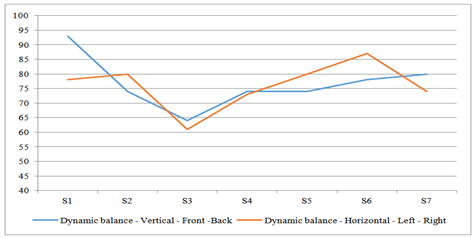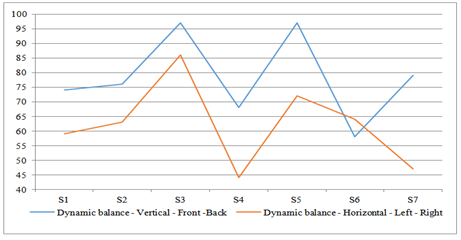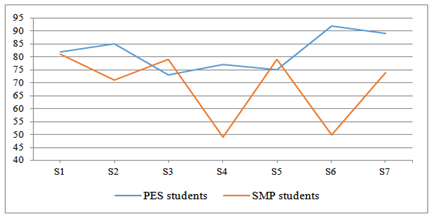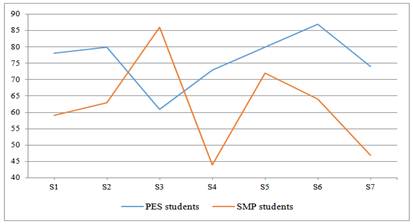Abstract
The purpose of the research was to determine what are the similarities and differences of the balance capacity encountered among second year students of Physical Education and Sports department. Fourteen students (8 boys and 6 girls) were measured during the experimental approach studying Physical Education and Sports (PES) and Sport and Motor Performance (SMP) programs, seven from each program. For the PES program five boys and two girls were measured, while for the SMP program, the group consisted of four girls and three boys. The measurements were focused on the investigation of the bipodal balance (static and dynamic). The results obtained showed a better balance capacity for PES students compared to SMP students, the biggest differences being recorded in static balance measurements (81,86% vs. 69%). The same trend was maintained in terms of horizontal dynamic balance (76,14% vs. 62,14%) with the observation that at the measurements that tested the vertically dynamic balance, SMP students had higher values compared to the colleagues from the PES program (78,43% vs. 76,71%). In conclusion, both groups of students showed similar tendencies in terms of dynamic balance, meaning that all students demonstrated a better vertical dynamic balance capacity and a wicker horizontal one. In terms of static balance capacity the subjects demonstrated oscillatory trajectories, the PES students showing better results than the SMP ones.
Keywords: Motor controlsensorial systemsport activities
Introduction
Balance is generally defined as the ability to maintain the body’s center of mass within its base of support and can be categorized as either static or dynamic balance. Static balance is the ability to sustain the body in static balance or within its base of support. Dynamic balance is supported to be more challenging because it requires the ability to maintain balance during a transition from a dynamic to a static state. Both static and dynamic balance require integration of visual, vestibular, and proprioceptive inputs to produce an efferent response to control the body within its base of support (Olmsted, Carcia, Hertel, & Shultz, 2002; Ross & Guskiewicz, 2004; Karadenizli et al., 2014). To maintain human body balance, anatomical and functional integrity of the vestibular system, located in the inner ear, is essential. The vestibulo-cochlear system has a dual function — the cochlea is responsible for the auditory function, and the vestibular system is responsible for body balance. However, hearing ability is actually a secondary feature, because the primary function of the auditory organ is to maintain body balance (Steindl, Kunz, Schrott-Fischer, & Scholtz, 2006; Northern & Downs, 2002; Melo et al., 2017). Maintenance of balance refers to the ability to respond to any small change by correcting the tension of the whole body. Furthermore, balance is a complex exercise control task that includes the integration of sensoryinformation and the response of the nervous system. Postural reaction is the process that works cooperatively by synergism of muscles between legs and body. In controlling balance, a sensory process is progressed through interaction between inputs that enter from the somatosensory system, visual system and vestibular system including the proprioceptive senses (Lim, Hwnagbo, Nam, & Cho, 2014; de Haart, Geurts, Huidekoper, Fasotti, & Limbeek, 2004; Woollacott, Shumway – Cook, &Nashner, 1983).
Usually, we can say that an individual has a good or bad balance capacity by the way he or she is able to practice different motions without being imbalanced, this thing being assess by the efficient positioning of the feet on the ground. The feet require proper weight distribution during many body motions such as those for the maintenance of static balance and gait. Therefore, the feet have impact-absorbing structures, such as transverse, medial longitudinal and lateral arches, to distribute the body weight during both static and dynamic states (Hyong Hyouk, & Kang, 2016).
Some studies suggest that the advanced levels of balance in highly experienced athletes may result from repetitive exercises that influence motor responses, or these advanced skills of the athletes may be related to proprioceptive and visual movement. Although they have not yet developed a common ground, the experts suggest that the alterations in both sensorial and motor systems influence balance performance (Bressel, Yonker, Kras, & Heath, 2007; Ateş, 2017).
Problem Statement
The students of physical education and sports faculties have different features in terms of motor skills and how they can adapt to different motor situations and activities. Motor experience can influence their psycho-motor behaviour during their specific activities of the study programs that are followed, most of the time, those who have practiced for a longer time a certain sport, at a higher level of sports classification, showing more availability in the achievement of the proposed educational and motor goals.
The study programs followed by the students involved in the research are oriented towards two directions: physical and sports education and sport and motor performance. Both include disciplines with a theoretical and practical character, their content being focused either to physical education or to performance sport.
Research Questions
We started this research from the hypothesis according which if we will measure the static and dynamic balance among the students of couple different study programs but specific to the physical education and sport faculties, then we will be able to identify if there are differences concerning the balance capacity of these students.
Purpose of the Study
The purpose of the research was to determine what are the similarities and differences of the balance capacity encountered among second year students of Physical Education and Sports department.
Research Methods
This scientific approach was designed based on the following research methods: the documentary informatics method - in order to identify and study the main researches that were achieved in the direction of this theme; the observation method – in order to monitor the behaviour of the subjects involved in this research; the statistical method - to process and centralize the recorded data from measurements; the testing method - to measure subjects' balance capacity, the graphical method - to highlight the trends emerging from the measurements.
Subjects
Fourteen students (8 boys and 6 girls) were measured during the testing approach, all of them studying Physical Education and Sports (PES) and Sport and Motor Performance (SMP) programs, seven from each program. For the PES program five boys and two girls were measured, while for the SMP program, the group consisted of four girls and three boys. The measurements were focused on the investigation of the bipodal balance (static and dynamic) using the Sensamove balance Miniboard. The SMP students were students who have practiced or are practicing sports in an sportive structure (Handball and Tennis) while the PES students were students who, most of them, have practiced sports like leisure activities.
Data acquisition
The software of the balance board provided real-time visual feedback so that the subjects had the possibility to see and adjust their neuromuscular response in order to be able to achieve the balance tasks. The results of each subject were recorded via balance board software, received a performance score expressed in percentage (%) according to the balance behaviour and were tabled according to the data acquisition design that was established for each student and balance test type.
In terms of tests tasks,
5.3. Data analysis
The data analysis was done via Microsoft Office Excel program using the following statistic parameters: average, standard deviation, the coefficient of variance, the correlation test and the "t" test. These indices were applied in order to see if there were any similarities or differences in terms of static or dynamic balance between the two study programs and to see if the differences were a significant ones.
Findings
The results obtained from the measurements allowed us to tighten the data, highlighting the trends recorded for the two types of balance (static and dynamic). In the following tables and graphs we can see the results of each subject, expressed as percentage (table

The data fron table
In table
Table

Table
Analysing the differences between the two types of equilibrium (table
Regarding the analysis of the general balance capacity (static + dynamic), the recorded data show that the differences between the students of the two study programs are statistically insignificant (table


As a general view, the results obtained showed a better balance capacity for PES students compared to SPM students, the biggest and significant differences being recorded in static balance measurements (81.86% vs. 69%). The same trend was maintained in terms of horizontal dynamic balance (76.14% vs. 62%), with the observation that at the measurements that tested the vertically dynamic balance, SPM students had higher values compared to the colleagues from the PES program (80.17% vs. 76.71%).
Conclusion
In conclusion, both groups of students showed similar tendencies in terms of dynamic balance, meaning that all students demonstrated a better vertical dynamic balance capacity and a wicker horizontal one. In terms of static balance capacity the subjects demonstrated oscillatory trajectories, the PES students showing better results than the SMP ones.
The higher values of vertical dynamic balance similarities may occur from the fact that the students are not very focused on the activities that require lateral dynamic balance tasks, most of the actions that the students (PES and SPM) practice being related to forward and backward directions. This fact may underline, one more time that, it is very important to practice exercises that require a variety of the sensorial system tasks in order to improve balance capacity in a proper way.
Acknowledgments
I would like to thank the students of Physical Education and Sport and Sport and Motor Performance programs for being part of this research.
References
- Ateş, B. (2017). Investigation of static and dynamic balance performances of female student-athletes and non-athletes between 12 and 14 years of age. Journal of Physical Education and Sports Science, 11(1), 1-8.
- Bressel, E., Yonker, J.C., Kras, J., & Heath, E.M. (2007). Comparison of static and dynamic balance in female collegiate soccer, basketball, and gymnastics athletes. Journal of athletic training, 42(1), 42-46.
- de Haart, M., Geurts, A.C., Huidekoper, S.C., Fasotti, L., & van Limbeek, J. (2004). Recovery of standing balance in postacute stroke patients: a rehabilitation cohort study. Arch. Phys Med Rehabil, 85(6), 886–895.
- Hyong Hyouk, I., & Ho Kang, J. (2016). Comparison of dynamic balance ability in healthy university students according to foot shape. J. Phys. Ther. Sci, 28, 661–664. doi:
- Karadenizli, Z.I., Erkut, O., Ramazanoglu, N., Uzun S., Camliguney, A. F., Bozkurt, S., ... Sirmen, B. (2014). Comparison of dynamic and static balance in adolescents handball and soccer players. Turkish Journal of Sport and Exercise, 16(1), 47-54.
- Lim, K.I., Hwnagbo, G., Nam, H.C., & Cho Y.H. (2014). Comparison of the effects on dynamic balance ability of warming up in water versus on the ground. J. Phys. Ther. Sci, 26, 575–578.
- Melo, R.D., Marinho, S.E., Freire, M.E., Souza, R.A., Damasceno, H.A., & Raposo, M.C. (2017). Static and dynamic balance of children and adolescents with sensorineural hearing loss. Einstein, 15(3), 262-268. DOI:
- Northern, J.L., & Downs, M.P. (2002). Hearing in children. 3rd Audição na infância. 5ª ed. Baltimore: Williams e Wilkens.
- Olmsted, L.C., Carcia, C.R., Hertel, J., Shultz, S.J. (2002). Efficacy of the Star Excursion Balance Tests in detecting reach deficits in subjects with chronic ankle instability. Journal of Athletic Training, 37, 501-506.
- Ross, S.E., & Guskiewicz, K.M. (2004). Examination of static and dynamic postural stability in individuals with functionally stable and unstable ankles. Clinical Journal of Sport Medicine, 14, 332-338.
- Steindl, R., Kunz, K., Schrott-Fischer, A., & Scholtz, A.W. (2006). Effect of age and sex on maturation of sensory systems and balance control. Dev Med Child Neurol, 48(6), 477-82. DOI:
- Woollacott, M.H., Shumway – Cook, A., & Nashner, L.M. (1983). Postural responses and aging: changes in the contributions of somatosensory, visual and vestibular input to balance control. Behav Brain Res, 8, 286–287.
Copyright information

This work is licensed under a Creative Commons Attribution-NonCommercial-NoDerivatives 4.0 International License.
About this article
Publication Date
15 August 2019
Article Doi
eBook ISBN
978-1-80296-066-2
Publisher
Future Academy
Volume
67
Print ISBN (optional)
-
Edition Number
1st Edition
Pages
1-2235
Subjects
Educational strategies,teacher education, educational policy, organization of education, management of education, teacher training
Cite this article as:
Ilie*, M. (2019). Similarities And Differences Concerning The Balance Capacity Of Sport Faculty Students. In E. Soare, & C. Langa (Eds.), Education Facing Contemporary World Issues, vol 67. European Proceedings of Social and Behavioural Sciences (pp. 1169-1176). Future Academy. https://doi.org/10.15405/epsbs.2019.08.03.143
